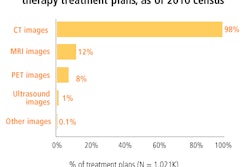
Determining suitably sized margins requires observations of prostate movement, for example, using the 4D localization system from Calypso Medical Technologies of Seattle. Measuring fluctuation patterns in a group of patients enables an expected target position uncertainty to be established for a particular setup. Appropriate margins can then be estimated from population-based rules that ensure, for example, at least 98% target coverage for at least 90% of patients.
Researchers from Virginia Commonwealth University in Richmond, VA, have examined inter- and intrafraction prostate movement for 17 patients who received radiotherapy with implanted Calypso transponders. The study also simulated the effects of motion correction strategies that may be employed to improve alignment accuracy and reduce margins (International Journal of Radiation Oncology, Biology, Physics, October 7, 2010).
"Knowing how much target motion differs from day to day and during treatment is key to achieving margin reduction and/or dose escalation," explained lead author Zhong Su, currently at the University of Florida Proton Therapy Institute in Jacksonville, FL. "This study not only helped us understand our patient target motion characteristics, but also provided insight into the effects of different treatment intervention strategies."
Motion analysis
The researchers analyzed Calypso tracking data from the 17 prostate cancer patients. Prior to each treatment fraction, the patient was positioned using skin marks placed during CT simulation, and then aligned using the Calypso system, with the treatment table adjusted to account for any interfraction motion. "Calypso is a nonionizing radiation target tracking device with submillimeter accuracy and a relatively high update frequency of 10 Hz," Su explained. "That's why we chose to work with it."
During treatment, the Calypso system monitored the position of the planned isocenter. On average, prostate tracking measurements were performed for eight minutes per fraction, for 28 fractions for each patient. If the isocenter position deviated by more than a preset amount (5 mm for over 25 seconds on any axis), treatment was interrupted and the couch adjusted accordingly (this occurred in 14 treatment sessions).
The researchers examined systematic and random components of the initial setup and prostate motion errors. Data revealed that interfraction motion errors, both systematic (left-right [LR]: 2.3 mm, superoinferior [SI]: 3.4 mm, and anteroposterior [AP]: 4.7 mm) and random (3.7, 2.7, 3.5 mm), were much larger than their intrafraction counterparts (systematic: 0.3, 0.5, 0.6 mm; random: 0.7, 1.4, 1.9 mm). They also saw a significant positive correlation between prostate motion in the AP and SI directions, indicating that the prostate had a tendency to move in the AP-SI plane.
These errors were used to calculate appropriate PTV margins for various daily patient alignment scenarios. With skin mark-only setup, the required margins were 8.4, 10.8, and 14.7 mm in the LR, SI, and AP directions, respectively. With online correction (using Calypso) prior to each treatment session, and considering just the errors resulting from intrafraction prostate motion, margins of 1.3, 2.3, and 2.8 mm in the LR, SI, and AP directions, respectively, were needed.
Correction strategies
The researchers also used the tracking data to simulate the effect of strategies employed to correct intrafraction motion. These included: a threshold-based approach, which interrupted treatment and repositioned the patient whenever the prostate moved more than a preset distance (3 or 5 mm) along any axis for more than 20 seconds; and a time-based approach, in which the patient was repositioned at preset intervals (every two or four minutes).
All of the intervention strategies reduced the mean prostate excursion distance during treatment. "Threshold-based motion management is used in the clinic now," Su noted. The two-minute repositioning approach caused the most significant reduction, except for in one patient. For 13 patients, four-minute repositioning outperformed the threshold-based approaches.
Simulations revealed that threshold-based and time-based strategies both reduced the PTV margins. The 5-mm threshold approach gave the least benefit, while the 3-mm threshold approach yielded modest margin reductions (to 1.1, 1.8, and 2.3 mm), compared with no intrafraction adjustments. In contrast, fixed-frequency adjustments reduced the margins to roughly two-thirds (0.8, 1.4, and 1.9 mm) and one-half (0.5, 1.0, and 1.5 mm) of the original margins, for four-minute and two-minute repositioning, respectively.
The researchers also calculated the related time costs of these interventions, for in-room (45 seconds) and remote treatment couch adjustment (15 seconds). Time-based strategies led to longer treatment times than threshold-based approaches. Treatment time increased on average by 53.8% for the two-minute correction approach with in-room adjustment, and by 10.8% using remote adjustment. In addition, time-based corrections increased the number of instances when the setup correction was made during transient excursions.
The authors point out that this time penalty could prove a reasonable trade-off against a twofold margin reduction. However, they note that it will only add clinical value if other sources of error -- including Calypso measurement errors, prostate delineation errors, and prostate deformation and rotation -- are reduced to comparable levels. The selection of time-based or threshold-based motion management also depends on factors such as patient load, availability of remote couch shift function.
Su is now studying the effects of prostate intrafraction motion on proton therapy using double scattering and uniform scanning techniques.
By Tami Freeman
Medicalphysicsweb editor
December 20, 2010
Related Reading
Calypso launches clinical study, October 27, 2010
Calypso nets FDA OK on gating feature, October 12, 2010
Varian contributes to novel research, March 4, 2010
© IOP Publishing Limited. Republished with permission from medicalphysicsweb, a community website covering fundamental research and emerging technologies in medical imaging and radiation therapy.



















